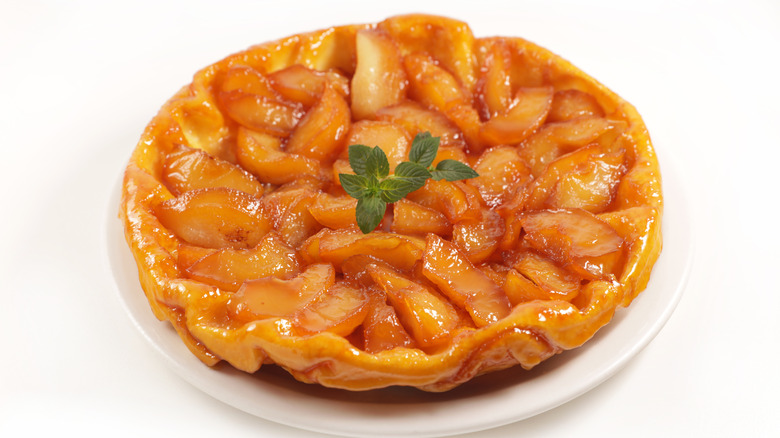The Fiery Way Gordon Ramsay Finishes Tarte Tatin
Like so much of rustic French cooking, the classic tarte Tatin features a handful of humble, quality ingredients that are transformed into an elegant dessert. Bon Appétit describes tarte Tatin as a French dessert traditionally made with apples and simple caramel with pastry dough. After the dessert has been cooked and the pastry has turned golden brown, like an upside-down cake, it is gently flipped over so the fruit is on top. While baking in the simple caramel, the apples become tender and shiny, per Bon Appétit.
A recipe from Martha Stewart calls for five to six apples, with Braeburn or a similar type of apple recommended. James Beard doesn't specify what type of apple is best for the tarte Tatin but does say they should be cut into a combination of quarters and thirds. When placing those apples in the pan, Martha Stewart says they should fill the space so that when the pan is turned over, it doesn't collapse. Just as the ingredients are important in the tarte Tatin, so is the pan. James Beard suggests using a skillet instead of a pie pan, but not just any old skillet will do; go with a cast iron, enameled cast iron, or a special tarte Tatin mold that can stand up to the heat of the oven. Having a durable skillet will also aid in the final, intense step in Gordon Ramsay's tarte Tatin recipe.
Touched by fire
During a presentation on an episode of Season 10 of "MasterChef," Gordon Ramsay shows the contestants how to create a beautiful tarte Tatin. The contestants are clearly impressed with Ramsay's precision while rolling out the dough and flipping the cast iron skillet over onto a plate, but it's the fiery finish that has them in awe. After having the studio lights turned down, Ramsay pours cognac into the hot skillet, tilts it so the alcohol starts on fire, and then pours it over the tarte Tatin to flambé it. The dessert is then finished with some powdered sugar that Ramsay dusts onto the pastry.
According to MasterClass, flambé means "flamed" or "flaming" and instills a light flavor of liquor on the food, which is typically a dessert, such as bananas foster. Besides the subtle flavor that it creates, MasterClass also says that flambé is done to create a caramelization flavor and to add some excitement to the presentation. Any liquor that is used must be at least 80-proof with cognac, dark rum, brandy, bourbon, whiskey, and kirsch being some of the best for the flambé process.
If lighting liquor on fire is a bit too much for you, don't worry. It's an optional step and Gordon Ramsay isn't judging you.

